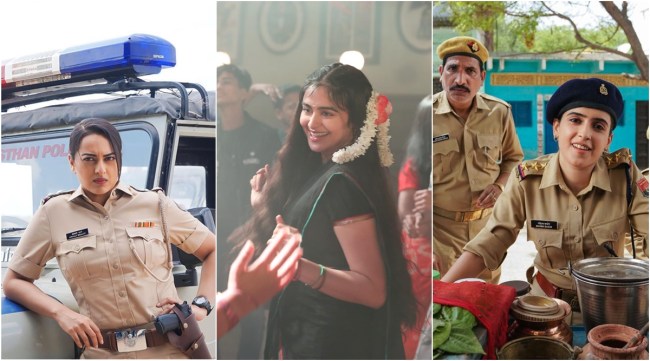Opinion Kathal, Dahaad, The Kerala Story and one question: Why do women run away?
While ‘Dahaad’ and ‘Kathal’ understand why someone might want to escape, ‘The Kerala Story’ treats the impulse as born out of ignorance. Women can only be trapped, misled and ‘converted’ to the other side
 Screengrabs from Dahaad, The Kerala Story and Kathal, via official Instagram pages.
Screengrabs from Dahaad, The Kerala Story and Kathal, via official Instagram pages. In his poem ‘Bhaagi Hui Ladkiyaan’ (‘The Runaway Girls’), Alok Dhanwa writes that the oppressiveness of the home becomes visible when a woman runs away from it. In the recently released Dahaad, Kathal and The Kerala Story, the runaway, abducted, or missing girl makes a recurring appearance. These are stories of girls who are abducted, but also those who want to run away. Girls who go missing and girls who do not want to stay. Girls who want to return, but cannot.
While Dahaad and Kathal understand why someone might want to escape, The Kerala Story treats the impulse as born out of ignorance. Women can only be trapped, misled and “converted” to the other side. Even when they think they are making a decision themselves, they are actually being brainwashed. In the first few minutes of the film itself, its protagonist Shalini/Fatima keeps reminding us that she was “programmed” to become an ISIS agent.
This insistence on things not being in someone’s control masks a wider agenda — they can be forgiven and rescued because it was not their doing. Rescue is central to this imagination because it helps in the political mobilisation against a whole community. The girl has to be saved from a demonised Muslim other. Her own will, desire or happiness is not useful. Her victimhood is.
Interestingly, Dahaad too centres on young women who are misled and seduced by a psychopath. But the eight-episode series does something different — it empathises. It suggests that, perhaps, the desire to escape can be traced to the oppressive structures of family life itself. One of its main protagonists, the cop Anjali Bhaati, is facing pressure from her mother to get married irrespective of her own desires. For societal rules, not for love. And so Bhaati understands why the missing women bought into the promises of a man they barely knew, so easily. They were made to feel worthless every day, and his calculated love felt like the only thing that would give value to their lives. In an uncaring world, he appeared caring.
In both Dahaad and Kathal, women are missing but the law does not notice until it serves a larger agenda. The targeted women come from marginalised backgrounds making their disappearance go unnoticed. In the satirical Kathal, the wider agenda is serving the interests of the political class epitomised by the missing jackfruits that drive its story. It is while chasing this case that its protagonist police inspector Mahima Basor chances on the case of a missing girl.
The more incisive Dahaad includes a sharp critique of the so-called “love jihad”, which uses women’s personal lives for its own political agenda. A character discovers that his missing sister becomes a case worth investigating for the police only when he lies about the religious identity of the boy she eloped with.
Later in his poem, Dhanwa writes of a silence over the missing girl for the sake of respectability — “tum toh chupaoge pure zamaane se uska sanvad” (“You will hide this news from society”). Perhaps the box-office appeal of The Kerala Story, along with its conspiratorial fantasy, is that it no longer wants to disown the tainted woman of its imagination. It does not question her morality, even as it blames her naivety — which it then uses as ammunition to incite. It cares neither about storytelling nor about its selective audience who it wants to keep in a state of outrage by claiming its fiction is based on real life. It appeals to the insecurities of a majoritarian patriarchal worldview but frames its agenda as well-meaning — it needs to mobilise itself in order to protect its own (and only its own).
This devious imagination is masked as one of welfare and protection towards “their” women. But while it claims to care for women’s well-being, it almost needs her misery in order to prove its point and settle scores. That is why the elevated numerical figure of supposed forced conversions is so important to this discourse. The number is 32,000 women, it claims, not three. In this imagination, a woman can only be “ours” or “theirs”, never her own.
Magazine is a writer and teacher






